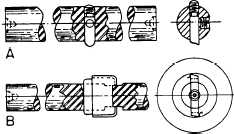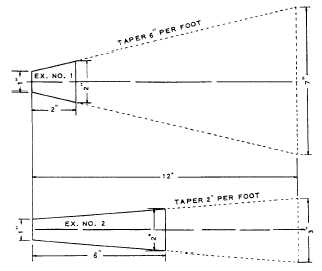Figure 9-30.–Boring bars.
Figure 9-31.–Tapers.
of large diameter. The head is fitted with a fly cutter
similar to the one shown in view A of figure 9-30. The
setscrew with the tapered point adjusts the cutter to the
work
TAPERS
Although you will probably have little need to
machine tapers, we have provided the following
explanation for your basic knowledge.
A taper is the gradual decrease in the diameter of a
piece of work toward one end. The amount of taper in
any given length of work is found by subtracting the size
of the small end from the size of the large end. Taper is
usually expressed as the amount of taper per foot of
length or taper per inch of length. We will take two
examples. (See fig. 9-31.)
Example l.–Find the taper per foot of a piece of
work 2 inches long. The diameter of the small end is 1
inch; the diameter of the large end is 2 inches.
The amount of taper is 2 inches minus 1 inch, which
equals 1 inch. The length of the taper is given as 2 inches.
Therefore, the taper is 1 inch in 2 inches of length. In 12
inches of length the taper is 6 inches. (See fig. 9-31.)
Example 2.–Find the taper per foot of a piece 6
inches long. The diameter of the small end is 1 inch; the
diameter of the large end is 2 inches.
The amount of taper is the same as in example 1,
that is, 1 inch. However, the length of this taper is 6
inches; hence the taper per foot is 1 inch times 12/6,
which equals 2 inches per foot (fig. 9-31).
SAFETY PRECAUTIONS
In machining operations, always keep safety in
mind, no matter how important the job is or how
well you know the machine you are operating.
Listed here are some safety precautions that you
MUST follow:
1. Before starting any lathe operations, always
prepare yourself by rolling up your shirt sleeves and
removing your watch, rings, and other jewelry that
might become caught while you operate the machine.
2. Wear goggles or an approved face shield at all
times whenever you operate a lathe or when you are near
a lathe that is being operated.
3. Be sure the work area is clear of obstructions that
you might fall or trip over.
4. Keep the deck area around your machine clear
of oil or grease to prevent the possibility of slipping or
falling into the machine.
5. Always use assistance when handling large
workpieces or large chucks.
6. NEVER remove chips with your bare hands.
Use a stick or brush, and always stop the machine.
7. Always secure power to the machine when you
take measurements or make adjustments to the chuck.
8. Be attentive, not only to the operation of your
machine, but also to events going on around it. NEVER
permit skylarking in the area.
9. Should it become necessary to operate the lathe
while the ship is underway, be especially safety
conscious. (Machines should be operated ONLY in
relatively calm seas.)
9-19







